My time in Bad Godesberg was largely uneventful. What once was a small town with its own castle on a hill had since been subsumed by the urban expansion of Bonn. The sleeping arrangement that I had procured was certainly the most interesting part; I found myself making camp in a house in the middle of town, the walls of which were filled with Arabic writings and middle-eastern wall ornaments. With the ambient sounds of a televised football match and muffled Arabic commentary filtering through the walls, I drifted off to sleep.
The road to Koblenz
My next major destination was the city of Koblenz, a few days away. These days marked a transition period in the trip; I was following the Rhine fairly strictly, and this practise would only grow stronger as I headed further upstream towards its heart and its most romantic points.
After Bad Godesberg, I left North-Rhine Westphalia (Germany’s most populous state) and entered the Rhineland-Palatinate. I had walked across an entire Bundesland — an entire state. An encouraging sign of progress. My reward for said achievement revealed itself a little later in the day…
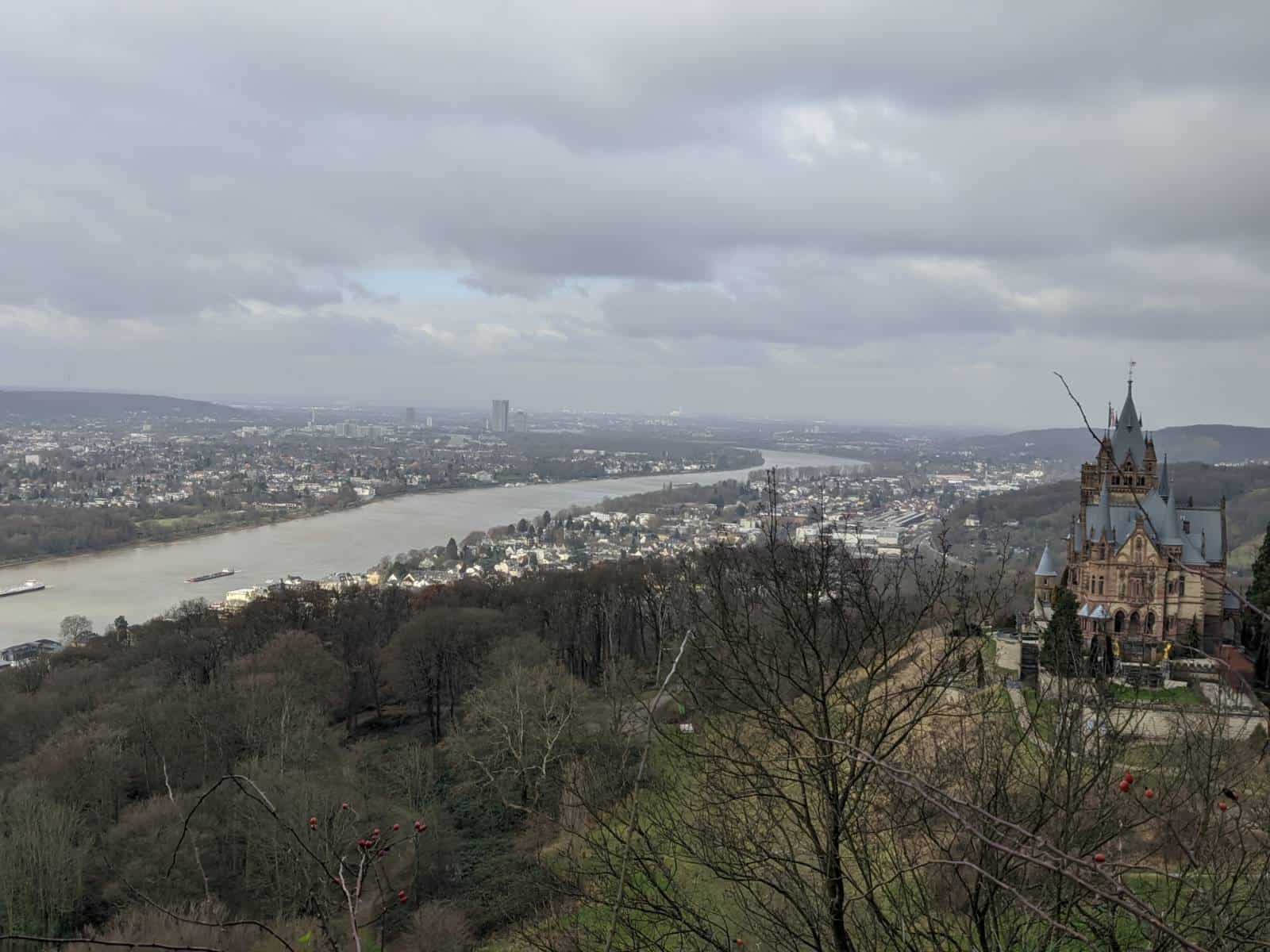
A portrait of Unkel
In the mid-afternoon sun, I arrived at a small village right on the bank of the Rhine, called Unkel. It was a wonderfully pretty town: with charmingly restored classic half-timbered houses that sat handsomely in squares or by the small alleyways, which all headed back towards the Rhine. The great river was never more than a few hundred yards away. On a whim, I popped into it’s Catholic parish church, complete with refractory and rococo alter. As I walked its narrow streets, I became so taken with it, I decided to set down here for the evening.



After an evening excursion to Lidl on the edge of town to source my supper – a huge five-minute trek away – I supped on a bench on the river promenade. Unkel was in many ways exactly what I wanted it to be, exactly how I’d pictured the miniature villages which dotted the banks of the Rhine I’d hoped to come across.

As the sun set over a hill across the river, I sat opposite, taking in the glowing pink sky which had emerged. There I watched until the surrounding hills and mountains faded into a pale pinky-grey backdrop, and finally settled into their form as black miniatures as the background to slate roofs and lapping waves.
I sat on a bench by the river watching barges float upstream, as the last embers of the sun died down.

The march to the top of the hill
A couple of days later, after passing through Unkel, Leutesdorf, and admiring Andernach from across the river, I arrived in the outskirts of Koblenz. It was mid-afternoon, and for the first time it felt genuinely warm and sunny. Spring was just around the corner.
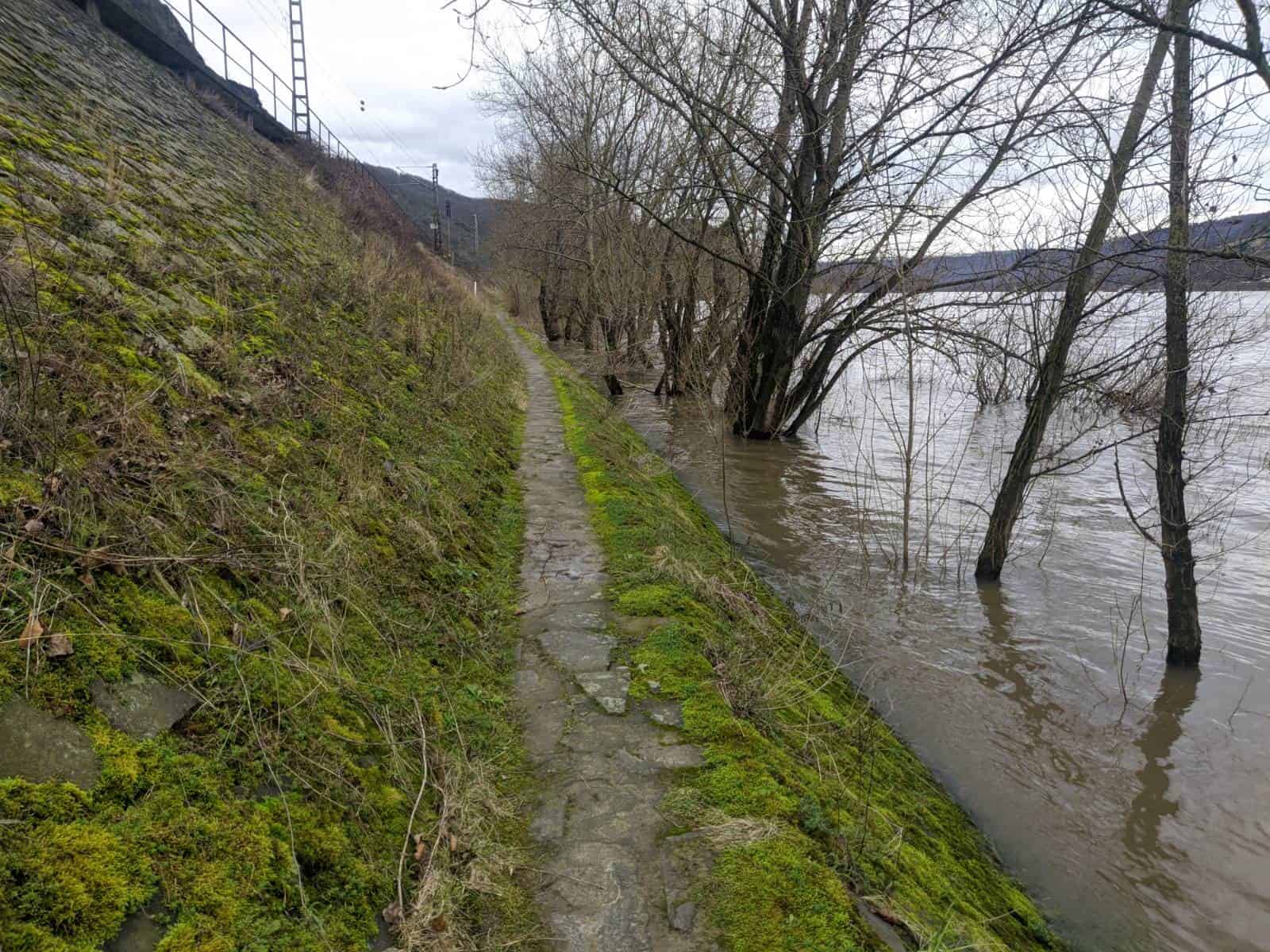

Koblenz is the site of the confluence of two of the great European rivers: where the Moselle meets the Rhine. The two rivers converged at the tip of a headland on the opposite side of the river from which I approached. This prominent point is called Deutsches Eck (Germany corner). As I walked, I was greeted, both by the two rivers, and the large bronze statue of Wilhelm I on horseback who sits guarding the corner.
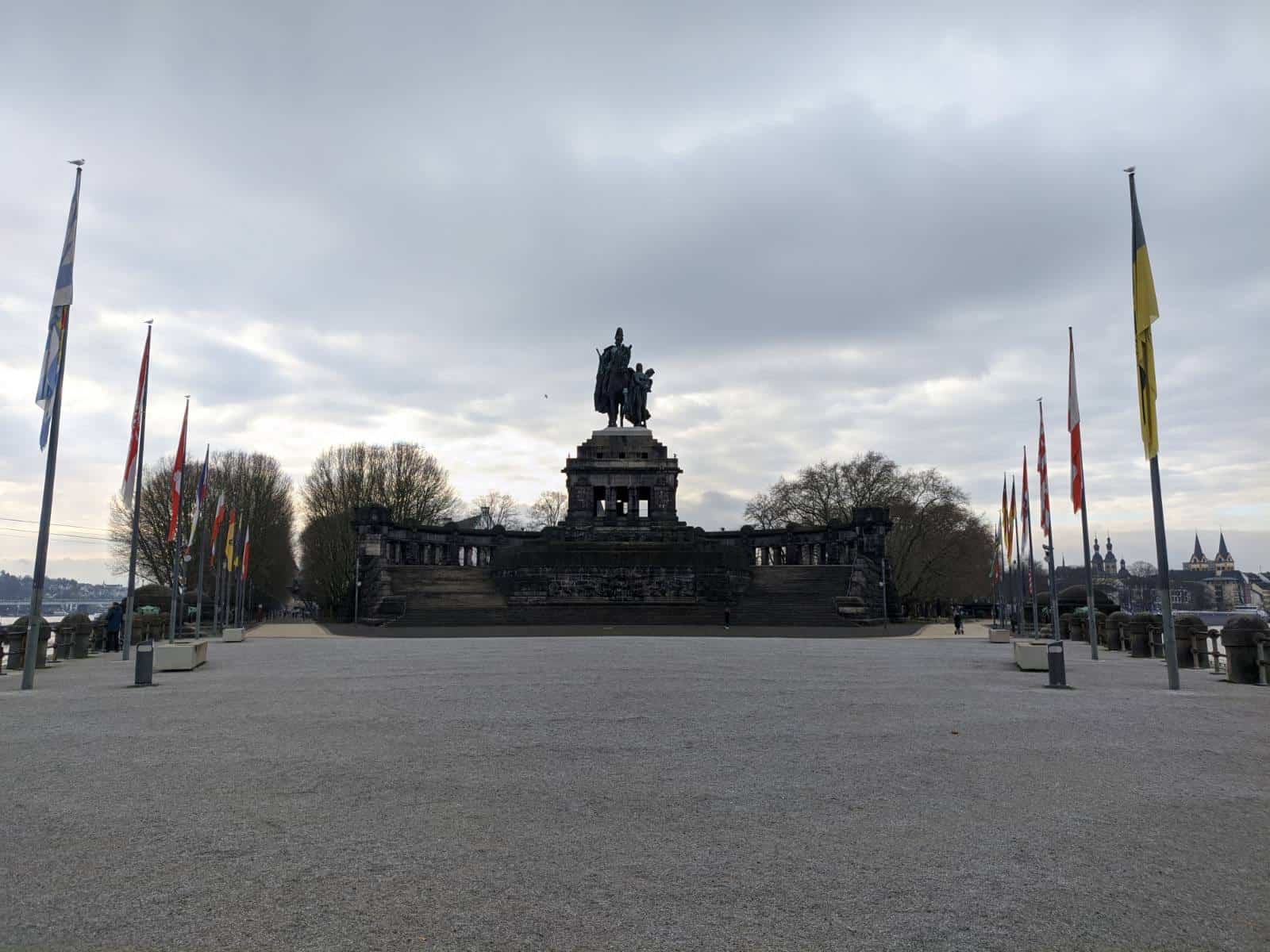
I reflected on the significance of this spot for German nationalism in the past. It was places like this that inspired patriotic romantic poets, and the German abnegation of any French claims to the region. With poems and songs such as ‘Die Wacht am Rhine’, the first German Kaiser seems an appropriate figure for the very German of spots, despite its controversial reinstatement in the 1990s following its toppling in WWII.
My entry into Koblenz was absolutely stunning. My hostel was in a fort atop the large hill opposite the city. A golden hour settled on the city as I began my winding ascent. I started up my summer playlist (for the first time since last year) and practically danced my whole way up the steep steps towards the summit.
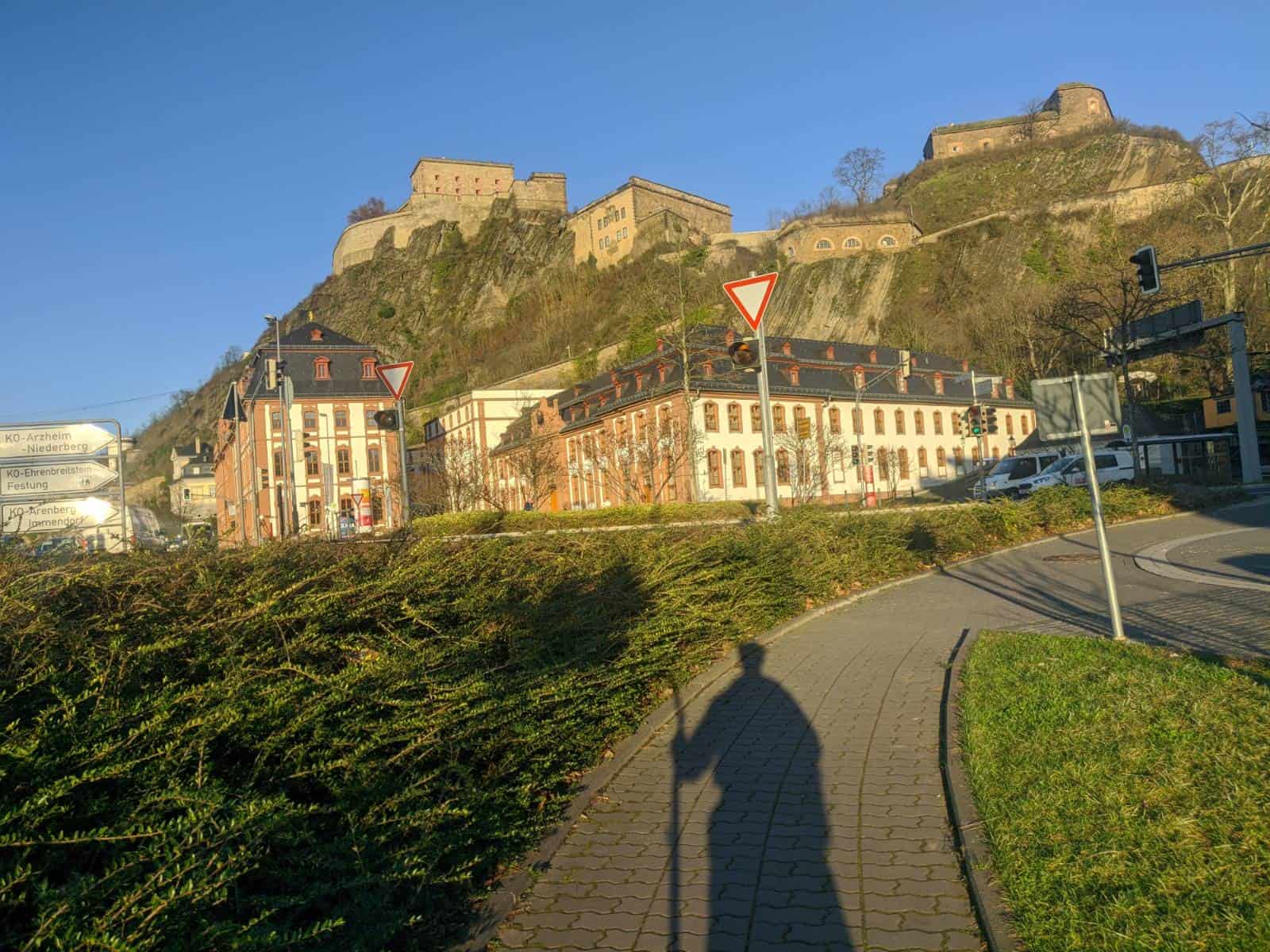

A man of ”UNESCO-certified” culture
The next day, I explored town for a few hours. I trekked back down the hill and across the river. The small old town was pretty, though I concluded Koblenz was more about the overall look and feel of a historically and geographically significant place, than any specific buildings. Most of the day was really a “self-love day”. I switched off my phone, read my book, took a shower, and watched TV. And all, that, jazz.
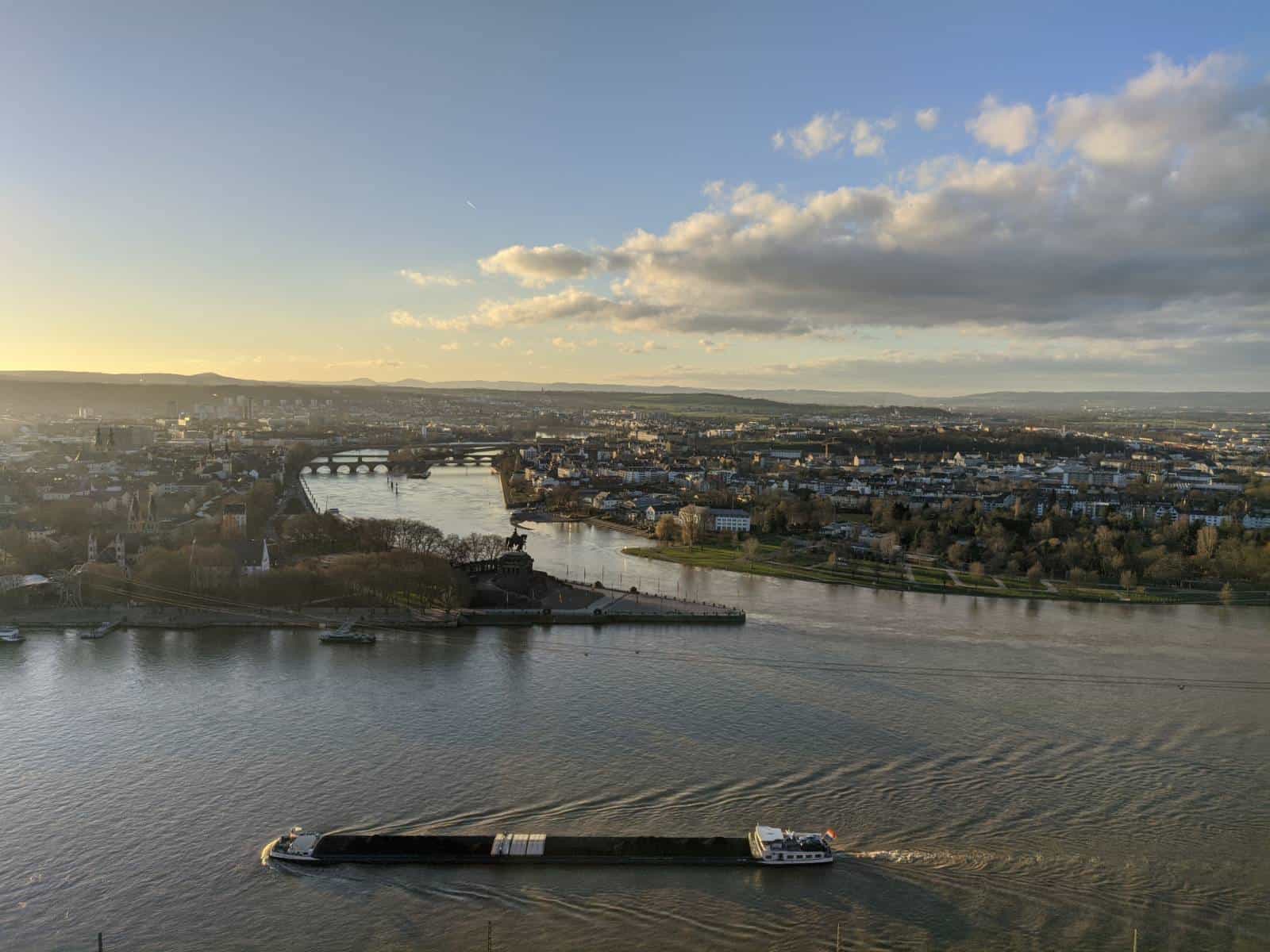


Having descended from my fort on high the next morning, I met the riverside path. What a surprise, eh! Walking out of Koblenz, I passed a group of little people on what appeared to be a geography field trip. They were peering down at the water’s edge as a teacher spoke to them, gesticulating animatedly. When the teacher saw me, he called to the children, and the sea of little people parted to allow me through, staff and all. Perhaps I would have had more enthusiasm for the subject of Geography in school, had our excursions been on the Rhine and not a beach in Wales just off the M4. Not much of a competition there.
The stretch of the river that I had reached is called the Upper Middle Rhine Valley, and is the most celebrated stretch of the river: the 40 odd miles between Koblenz and Bingen are a listed UNESCO World Heritage Site. I was truly heading upstream.
About an hour into that day’s walking, the heavens opened with hale for the first time that day. It was my by-now-long-developed experience and the nous of my craft – and not at all sheer fluke – which allowed me to successfully preempt this turn in the elements and to have already taken the necessary precautions. However, after braving the hale and rain for a quarter an hour, the weather and the gloom, which had settled on the valley, suddenly abated. The only sign of the foul weather which had passed was the damp conditions underfoot: the now-clear skies put on a front of ignorance and innocence. It continued this practice for next few hours; for five minutes of each hour, a torrent of hail would descend, before the sun and blue skies would emerge, all brazen and confident.
Earlier that, day I had come across some workmen on the banks of the river. Upon seeing my pack and my stick, they enquired as to where I was headed, and I replied Boppard; this was a popular answer and resulted in some excited recommendations as to places to visit and cheerful salutations as I made my way.
On the east side of the river, some time later, I waited for a short while for a ferry to take me across into the town of Boppard. It was a small town, with a large church — as is the custom across much of Germany. With the trademark half-timbered design and colourful buildings lining the river, it fulfilled its promise as a Rhine-side stop.



King of the castle
The next day, I made my way to the town of Bacharach, which was very similar in style to my stop the previous day. Despite a chill in the air, the sky was bright and blue, and I followed the same riverside path the whole day. I stayed that night in the castle – Burg Stahleck – above the town! It had been converted into a youth hostel; an idea which seemed so bizarre and refreshing, it fuelled my walking pace that day.


Having scaled the castle, and then scaled the slim tower that guided me to my lodgings, I took in the Rhine and headed to the mess hall. I was sat watching the Six Nations – the French game – on my phone, when a young boy came up to me, pointed at my shorts, and asked where my trousers were. This prompted great laughter from his large family at the other end of the dinning room — though his mother seemed a tad embarrassed!


Water, water everywhere
On my way to Bingen the next day, I opted for a relaxed start and early on found a sandbank upon which I sat and read. I found the common nature of sand beaches along the Rhine to be quite surprising at first. From these beaches often spanned lines of stones and boulders which intersected the river horizontally from the sandbanks. These break up the rapids and the regular flow of the river. Ever-opportunistic, moss grows on the boulders and pebbles, and serves as the resting ground for native bird populations, who stand on guard in the middle of the river serenading the barges heading up and down stream with their morning tune.
As I sat by the river, I witnessed an exemplary piece of comic amateur cycling. On the path behind me, a group of wannabe peloton riders fully clad in latex were cycling past. A cry went up from the leader: “Achtung!”, which was duly echoed in canon back by the other four riders all in tight formation around him. And so goes the thrilling tale: together they somehow all managed to successfully navigate the hurdle ahead of them — the tiniest stream of spring water which trickled over their path. Phew.
Later, as I came to a bench by a public beach, a group of friends out for a winter picnic beckoned me over, and invited me to have some lunch with them. I chatted with Pete, Silke, Juergen and Odo for an hour or so, and listened as the former, a Dutch expat, told me his plans to open up a café and bakery in the nearby town in the coming year; I had sampled his bread baked fresh that day and thought it excellent.

Bingen came and went, and soon I found myself approaching the city of Mainz; I drew up ready to explore.
A question of technique
The road-crossing technique I’d been exercising thus far was one of a practiced Londoner: crossing sensibly when the coast was clear. Let’s just say, that is not the German way. It could be 3am in the middle of nowhere, a car hasn’t passed for hours, and yet they would still obdurately wait for the green man. My savvy style had thus far raised a few eyebrows. However, I was about to meet my match. As I entered the city of Mainz, a middle-aged man took issue with my methods.
He reprimanded me in rambling grunts: “Think of the children”, he cried.
I struggled not to laugh. And I replied with an admittedly childish and sarcastic thumbs up, followed by an open-palmed gesture towards the otherwise completely empty street. There were no children. Just us. A true battle of wits and a great display of eloquent discourse by both parties.
Fear not, reader: this incident only encouraged me. I liked to think that I had inadvertently started a road-crossing revolution across the plains of Germany; opening people’s eyes to a much more pragmatic way of life. In reality, I probably struck people as a wandering heretic with a big stick.
The logbook has updated too! You can view the logbook of my walk, here.

Noah,
Loved this entry and also the wonderful pictures!
Takes us back to our cruise on the Rhine at least 17 yrs ago!
You are an amazingly descriptive writer and have a way with words!
Continued safe travels.
Aunt Sharon and Uncle Ken
The real question is why are you wearing shorts in early March?
The sooner you start wearing shorts, the sooner summer arrives. Basic logic, Gabrielle.
Sending you lots of love and Colombian Hugs! keep up and look after yoursefl!
KAKA, JOSE, SOFI & MARI